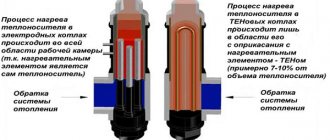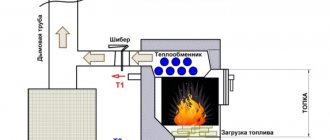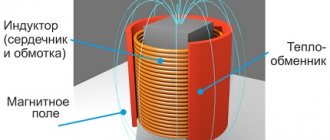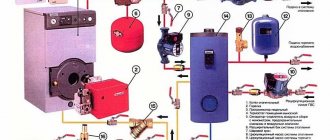What does the heating system consist of?
The list of necessary equipment depends on the heating organization scheme. Let us list the main components for the entire set of solutions.
A gas boiler. Its function is to heat the coolant. It is often equipped with a closed expansion tank, and sometimes with an electric circulation pump. The choice of such a layout facilitates the design and installation of a heating network. The boiler is selected based on the power required to heat the living space.
[!] The standard formula “100 W per 1 m²” is averaged. In reality, the required power depends on the heated footage, because its increase is disproportionate to the increase in the area of enclosing structures - the main cause of heat loss. If heating 100-150 m² requires 130 W per meter, then 80 W will be enough for 400-500 square meters.
Heating appliances. They are needed to release heat to maintain the desired temperature in the room. These can be cast iron, steel, aluminum or combined radiators. Their energy efficiency depends on the material and number of battery sections, and is expressed in heat transfer and inertia.
Pipeline. It is used to transfer and distribute coolant between batteries. For its deployment, seamless products made of polypropylene or steel are mainly used. The low coefficient of internal resistance allows their use in heating systems with forced and natural circulation.
[!] Additives included in antifreeze can destroy the polypropylene heat pipe. If the house is not permanently inhabited, steel structures should be used.
Fitting. Necessary for connecting pipes. It is important that they do not violate the tightness and do not reduce the permeability of the heat pipe.
Expansion tank. Compensates for pressure surges inside the heating network caused by the ability of a substance to expand when heated. Eliminates the risk of destruction of its individual components. There are open and closed types of designs. The use of the latter is preferable due to their versatility, safety and ease of maintenance.
[!] Since the operation of an open expansion tank is associated with evaporation of the coolant, antifreeze cannot be used in this arrangement.
Shut-off valves. Allows you to disconnect individual elements of the heating network from the circuit for maintenance or adjusting the temperature in the room.
Safety fittings. This category includes a balancing valve, an automatic air vent (Mayevsky valve), check valves and safety valves. Their tasks are to prevent the occurrence of throttling flows and protect the system from water hammer.
Control valves. Designed to balance the heating system and control the heat transfer of individual radiators. This helps to establish an individual microclimate in each room without changing the overall performance of the heating network.
Distribution manifold and hydraulic arrow. Responsible for separating hydraulic circuits and distributing heat transfer. Improves network permeability. Reduce heat loss. Since they serve as local control centers, a thermometer, pressure gauge, flow meter and other sensors are installed on them.
Electric circulation pump. Moves coolant along circuits. Installed on the return pipeline directly in front of the boiler.
Which pipes to choose for repairing or replacing the water supply system in an apartment
Today, pipeline parts made of various materials are widely used. It is worth taking a closer look at what the water supply system is now made of.
Steel products
Galvanized communications are still popular. By installing a steel pipeline with a zinc coating, it will be possible to ensure high moisture resistance, strength and reliability. Such pipe elements are:
- MBFT-75 Membrane for 75GPD
- SF-mix Clack up to 0.8 m3/h
- SF-mix Runxin up to 0.8 m3/h
- very durable;
- resistant to rust;
- having increased throughput (thanks to galvanization, plaque does not accumulate on the inside).
At the same time, they are quite expensive and are characterized by the complexity of installation work.
Copper components
Copper plumbing parts have proven themselves as one of the best decades ago. There are still ancient houses with pipelines made of this material, the service life of which is approaching a hundred years. In terms of durability, they surpass even polymer structures. They have excellent flexibility and a wide range of operating temperatures. In addition, such products look very attractive. However, the cost of output communications turns out to be very high; it fully corresponds to their numerous advantages. The only thing that can be noted as a minus is the low resistance to mechanical damage.
Plumbing systems made of polypropylene
When planning to replace the water supply and sewerage pipes in your apartment with polypropylene ones, you will certainly appreciate the cost of future repairs. Prices for pipe elements of this type are optimal. At the same time, for relatively little money you get high quality characteristics. These include a long service life and the ability to be used in adverse conditions. In addition, one cannot fail to note the ease of installation of the structures. Among the disadvantages, it is worth mentioning the operating temperature restrictions and the need to form permanent connections during assembly.
Metal-plastic pipelines
Products of this type are the most versatile. The material from which they are made ideally combines metal and plastic. The outer plastic layer is highly resistant to rust. Internal - provides strength, ductility and reliability. Thanks to modern developments, experts have been able to eliminate the biggest drawback of plastic - low resistance to pressure and high temperatures. The only downside worth pointing out is the need for periodic tightening.
Primary requirements
If the system is designed taking into account SNiP, there will be no problems with it. But this is not enough. A well-thought-out configuration has the following qualities:
- Energy efficiency (cost-effectiveness). This characteristic is especially important in climatic zones with low average annual temperatures and long heating periods. Maintaining a comfortable microclimate in the house is one of the main expenses of homeowners.
- Reliability and fault tolerance. Stopping the system in the middle of the heating season is dangerous for the health of residents. And regular temperature changes and prolonged freezing cause irreparable damage to the building.
- Maximum security. All possible negative scenarios should be foreseen and the risk of their occurrence should be minimized.
- Autonomous and easy to use. A well-thought-out heating system should operate without human intervention for as long as possible.
- Full controllability. In a well-implemented system, everything can be customized. Even the microclimate in each individual room.
- Aesthetics and noiselessness. The presence of heating engineering networks in the house should only indicate the temperature in the premises. And the operation of the electric pump can be clearly heard even during the day. And if this is not corrected, residents will stop sleeping at night.
Do-it-yourself replacement of plumbing and water pipes
When planning to change communications yourself, pay attention to a number of important nuances:
- First of all, decide on the preferred material for pipe structures.
- Do not forget that, among other things, you will have to purchase and install new water intake meters.
- Determine whether it is necessary to replace the shut-off valves where the water supply enters the premises.
- Find out exactly what set of tools you will need to carry out repair work.
- If water purification filters have not been installed previously, make sure they are available in advance. This is the only way to protect plumbing, household appliances and communications from premature failure.
When purchasing liquid purification devices, be sure to consider the products offered by ours. The products in our range are of high quality and have a long service life.
- During the installation of pipe elements, it may be necessary to install valves. To do this, you will have to shut off the common riser, which should also be thought about in advance in order to avoid unforeseen situations.
Only when all of the above issues have been resolved can you proceed directly to action.
System design for a two-story house
There is nothing complicated in arranging utility networks, but to develop a project it is better to turn to professional heating engineers. This will save you from miscalculations and help you save money.
If you want to do everything yourself, you will have to study the subject more deeply. Everything is important - from climate and layout to sound insulation and design. This will help you figure out which heating scheme will be optimal in your case: with forced or natural circulation, one- or two-pipe, open or closed type, with water or antifreeze as a coolant.
Diameter selection
In residential buildings, two types of pipelines are installed: made of metal or plastic of various sizes:
| Type of wiring | Parameters used |
| Tee | The main zone is made up of pipe elements of 25 mm, and the connections to consumer systems are made of 20 mm components. |
| Collector | For the connection from the riser to the distribution block, 25 mm are used, after which - 20. |
Features of forced circulation
The length of the heating circuit in two- and three-story houses is often too long for the choice in favor of a gravity-type heating system to be a justified decision. It also has other disadvantages that have made forced circulation schemes the de facto standard for large-area housing.
The coolant in such a system moves through the pipeline not under the influence of gravity, but due to the operation of an electric pump. Due to the closed circuit, the pump performance is affected only by the internal hydraulic resistance of the heating network. The number of floors is not critical.
Since the coolant moves faster than in natural circulation configurations, it does not have time to cool down much after completing a full circle. This ensures uniform heat transfer and gas savings. The system can operate in low temperature mode, i.e. You can also heat in the off-season, when it is not too cold.
Due to the high pressure in the pipeline, it is highly undesirable to use an open expansion tank. But he has so many shortcomings that there is no problem in this. The closed-type design of the tank allows it to be placed anywhere. And antifreeze can be used as a coolant.
Forced circulation also has disadvantages. The main one is dependence on electricity supply. A power outage causes the pump to stop. This leads to a cessation of heat supply and the occurrence of air pockets.
The problem is solved by installing an accelerating manifold. If there is a power outage, such a system will continue to function in natural circulation mode.
Since the electric pump creates a lot of noise, you will have to allocate additional funds for sound insulation. But if the equipment will be located in a separate room, this is not necessary.
When it becomes necessary to replace water supply elements
This difficult procedure can be performed independently or with the help of hired specialists. The reasons for carrying out work most often are:
- Blockages in the system that cannot be eliminated by cleaning. As a rule, this phenomenon is typical for steel plumbing elements with an impressive period of limitation. Slag accumulates on them from the inside, as a result of which the internal diameter significantly decreases. In such a situation, the pressure of the supplied liquid may be greatly reduced.
- Leaks. Pipe structures made of cast iron, metal or metal-plastic often leak. It is noteworthy that if such a defect appears in one place of the system, after some time it will certainly make itself felt in another. Trying to repair the pipeline is almost pointless. Leaking elements must be replaced.
- Unaesthetic appearance. Another important reason why homeowners decide to completely change the plumbing parts. Typically, this need arises when carrying out major repairs. When purchasing expensive building materials and new plumbing fixtures for installation, few people want to leave old, unattractive plumbing structures in place.
Equipment connection options
There are two main schemes: one- and two-pipe. Both options are divided into a system with vertical risers and horizontal lines.
Radial wiring is also used - in it, each radiator is connected separately to a centralized collector. Since in such a system the heating pipe is installed in the floor (an additional heating source), it does not violate the design concept of the room.
There are the following types of connection of heating devices:
- lateral;
- lower;
- diagonal.
In the first two options, pipes for supplying and discharging coolant are connected on one side of the pipe - respectively, from the side or from the bottom. When diagonal - from opposite and at different levels. The last type of connection guarantees the least heat loss.
The bottom connection is not recommended for use in circuits with natural circulation.
When connecting sideways, small radiators should be used (maximum 6 sections). With diagonal there are no such restrictions.
Classification of production materials
The raw materials used for the production of pipeline parts are divided into three types:
| Variety | general description |
| Metal | Steel (with or without zinc coating) |
| Plastic | Polyvinyl chloride, polypropylene |
| Composite | Metal-plastic |
When faced with replacing old water supply and plumbing pipes in an apartment in the kitchen, toilet or bathroom during renovation, it is important to remember that the installation of steel elements is done quite rarely. Yes, their service life is up to 50 years. But many refuse installation for two reasons:
- when carrying out installation work, it is impossible to do without specialized equipment (welding machine, pipe bender);
- Even galvanized material is susceptible to corrosion and requires systematic painting.
Copper structures are characterized by the greatest durability and corresponding high cost. Installing them yourself is also very difficult.
That is why, in the vast majority of cases, residential property owners prefer to install a pipeline made of metal-plastic or propylene. Pipe communications made from these materials are characterized by:
- ease of installation;
- long service life;
- attractive appearance;
- no need for additional processing.
To assemble and install a plastic structure, it is enough to have only a soldering iron and a couple of screwdrivers on hand. In this connection, the costs of carrying out the work are minimal.
Scheme options for a two-story house
Single-pipe wiring
The installation of such a system requires the least amount of materials. It is easy to design, and anyone can install it. It allows the connection of a heated floor, and it can be implemented either using an electric pump or using the principle of natural circulation.
There are such varieties:
- simple;
- "Leningradka".
A simple one-pipe circuit. Its peculiarity is that the coolant enters the next radiator only after the previous one is filled. Having passed the circle, the water returns to the boiler.
It is easy to design and inexpensive to implement. The main disadvantage is that the temperature of each subsequent battery is always lower than the previous one. Depending on the footage, the difference between the first and last may be so large that the use of such a system becomes impractical.
If you refuse to use an electric pump, energy efficiency will be achieved in an even smaller area. For a residential two-story private house, this option is most likely not suitable.
"Leningradka". This scheme differs from a simple single-pipe scheme in that the coolant moves freely along a looped circuit. It is forced into the batteries under the influence of pressure through special outlets.
Due to this, the water temperature is approximately the same throughout the entire length of the heating network. And by disconnecting individual radiators from it, you can set an individual microclimate in different rooms.
The low cost of implementation, as well as the ease of design and installation make this scheme one of the most popular.
Two-pipe wiring
Water in such a system is supplied and discharged using different circuits. This achieves higher energy efficiency over large areas. And more radiators can be included in the circuit without the risk of losing their productivity as they move away from the boiler.
However, such systems are more difficult to design. And their implementation will be more expensive due to the use of more materials and additional equipment.
In low-rise buildings, the following two-pipe schemes are used:
- dead end;
- beam or collector;
- "Tichelman Loop".
Dead end scheme. The best option for rooms where it is impossible to loop the circuit. For example, because of a doorway.
Many people don't like her because she is capricious. Since water is supplied and discharged in opposite directions, the coolant can close the circuit after the first radiator. Having found the path of least resistance, the water will go no further.
This problem is eliminated by using balancing valves and connecting batteries with pipes of a smaller cross-section than those used in the main line.
Beam scheme. It involves a separate connection of each battery to two collectors - supplying and removing coolant. This eliminates the risk of water looping inherent in dead-end wiring. An additional advantage of this approach is that the heat transfer of each radiator can be controlled centrally.
This is the most balanced and easily managed scheme. Allows you to combine even one- and two-pipe circuits. And its communications are easy to hide, which helps maintain the attractiveness of the interior. At the same time, it is the most expensive and labor-intensive to implement due to the separate connection of each radiator and the use of additional equipment.
It has one more drawback - it cannot be used to build a circuit with natural circulation. And the use of a pump is not always justified due to the dependence of the functioning of the system on the stability of the power supply.
"Tichelman Loop". The best scheme in terms of cost, energy efficiency, functionality and ease of maintenance. It is cheaper and easier to design and install than beam. It is completely devoid of dead-end disadvantages, despite the serial connection of batteries. Does not require fine tuning and is easy to manage.
Combined wiring
Often the most justified solution is to combine several different schemes. Various reasons force one to take this path. From the layout features to the reluctance to get rid of previously installed heating networks in the case when the second floor was recently completed.
General rules for organizing combined systems:
- Any number of circuits can be connected. Each of them can be responsible for heating one or more floors, rooms, or even part of a room. The only limiting factors are equipment characteristics and budget.
- Simple one-pipe configurations are ineffective with long heating circuits. Therefore, their use in a two-story house is possible only with a small living space.
- The warm floor is connected by a separate circuit.
If different circuits require different temperatures and pressures, a hydraulic arrow is used instead of a manifold.
Open and closed systems
An expansion tank is always used. The only difference is in its type, which determines what configuration you get - open or closed.
The open type expansion tank is in contact with the external environment due to the presence of an opening in the upper part. This limits the possibility of choosing the location of its installation (exclusively at the highest point of the heating network) and the coolant used (only water, no antifreeze).
It also has other disadvantages:
- you need to regularly add water due to evaporation;
- there is a high risk of air locks in the heating circuit;
- needs additional insulation when placed in the attic.
The closed-type expansion tank is less capricious due to its sealed design. It can be used in systems with antifreeze (used in country cottages where people do not live permanently), and it can be installed anywhere. Often it is initially an integrated component of a heat generator of a compact design.
How to change a heated towel rail
Even a novice plumber can replace the coil himself. This is one of the simplest types of plumbing work, which, unlike replacing the water supply pipes in an apartment with plastic ones, can be done by anyone with due diligence. To change the water heater:
- Shut off the water by turning off the shut-off valves or use the collector for this purpose.
- To dismantle the dilapidated structure, use an adjustable wrench.
- Install a new heated towel rail in the same place. In this case, you may need adapters. Don't forget to seal the joints with linen thread or fum tape.
- Check the system for leaks.
When purchasing a coil, choose products with a minimum number of welds, as they are more durable.
Compatible with different boilers
The wall-mounted design is suitable for any forced circulation configuration. Since such devices are often equipped with a built-in pump and a closed expansion tank, their use simplifies the design and installation of a heating network. But restrictions on maximum power will not allow you to cope with the heating of large areas.
There are single- and double-circuit layouts. The latter, in addition to heating, provide hot water supply.
The non-volatile floor units are compatible with any gravity or forced circulation single or dual pipe configurations. When connected to an electric pump, such a boiler can cope with heating any area. Allows open system assembly. The main disadvantage, which is also an advantage, is that the device requires a separate room with forced ventilation and a chimney.
Is it possible to replace communications yourself?
When a home is owned, the owner is responsible for the condition of the water supply on his property. Pipe communications are under pressure, so changing them yourself, without having the appropriate knowledge and skills, is an unsafe activity. No matter how hard an amateur plumber tries, he is likely to commit a number of violations. After all, assessing the build quality visually is quite difficult. Only professionals can handle this task.
In a situation where it is necessary to change the riser, work can begin only with the consent of the engineering and operating organization that monitors the condition of the house. The same applies to the installation of water meters. They are installed strictly with the assistance of a specialist and immediately sealed.
conclusions
Independent replacement of water supply pipes in an apartment or house with plastic is only available to those who have the appropriate knowledge and experience. Without professional training, it is impossible to achieve high-quality work. Any mistake, even a minor one, can result in serious problems for the homeowner (in the worst case scenario, you will flood several floors down). Faced with the need to pay for repairs to your neighbor's living space, you will spend much more money than you would pay for the services of a master.











